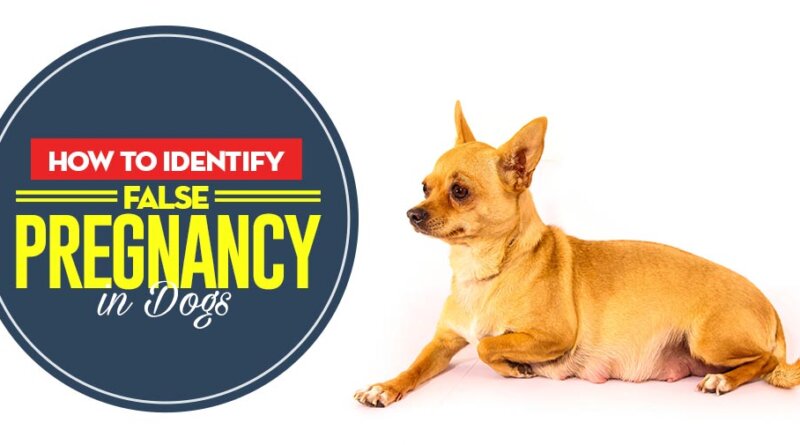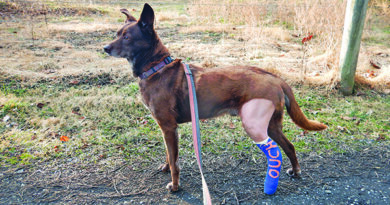How to Identify False Pregnancy in Dogs (Pseudocyesis) and What to Do
Here’s a situation: you have a female dog, and she isn’t spayed. She hasn’t had any unsupervised contact with uncastrated male dogs.
She hasn’t left your sight in the last months, and she is certainly not pregnant.
Yet, she acts like she’s pregnant.
This is a familiar condition called false pregnancy in dogs and you should know what to do about the symptoms you’re seeing.
Typically, female dogs will display all the key signs of maternal (mothering) behavior, feeling lethargic, and nausea.
They will also display some physical signs of pregnancy. And, all this is happening following their estrus (heat).
Do not worry – what your dog is experiencing is Pseudocyesis, commonly known as a phantom pregnancy, false pregnancy or just pseudo-pregnancy in dogs.
As unusual as it may seem, it happens fairly often in unsprayed and intact (virgin) female dogs.
If your female dog starts experiencing Pseudocyesis, keep calm and take her to your veterinarian.
A proper understanding of pseudo-pregnancy, as well as a timely visit to the vet, are the best things you can do for an ideal, clean resolution to the whole situation.
RELATED: How to Tell If Your Dog Is Pregnant
How to Identify False Pregnancy in Dogs
(pseudocyesis or phantom pregnancy)
Symptoms of False Pregnancy in Dogs
What should you expect when your dog is experiencing a Pseudocyesis? As the name suggests, the symptoms of phantom pregnancy in dogs are almost identical with those of an actual pregnancy.
Behavioral symptoms
Depression – your dog has suddenly become much more lethargic and withdrawn. It has much less enthusiasm for play and walks and displays general apathy.
Anxiety – she is more easily startled and feels much more uneasy.
Restlessness – your dog can’t seem to find a place to sit, she constantly changes positions and even whines quite a lot.
Nesting behavior – if your dog just destroyed a blanket or a roll of paper and formed a nest in some corner of the house, then she is nesting for the puppies she feels are coming.
Digging – a more specific side-effect of her nesting behavior, your dog might start digging, or at least try to, in order to prepare a nest for her non-existing puppies.
Mothering – as in actually pregnant dogs, dogs with phantom pregnancy can sometimes display maternal behavior towards a stuffed toy, a pillow or a shoe. They would take such an object to the prepared “nest”, and try to cuddle and nurture it. This happens sometimes even to pregnant dogs when the mothering instincts kick in before the actual birth.
Excessive grooming – a part of the mothering instincts of dogs can sometimes be the overly active self-nursing. Your dog may start taking some extra care of her coat and her belly.
Aggression – not uncommon sign of pregnancy and phantom pregnancy in dogs, can be aggression towards other dogs and people, and even towards you.
Physical symptoms
Mammary glands enlargement – as in an actual pregnancy, the mammary glands of a dog with a false pregnancy can often fill with milk in preparation for puppies.
Mammary glands secretion – sometimes, the mammary glands of your dog can even start secreting milk.
Abdominal distention – an enlargement of a swelling in the abdomen is not uncommon in either an actual pregnancy, or a false one.
Weight loss – usually out of depression and anxiety, your dog may start eating less and as a result – lose weight.
Weight gain – other times, in preparation for the birth (and in absence of a depression or anxiety) your dog may start to eat more and gain weight.
Nausea and vomiting – typical pregnancy signs in not even just dogs.
Lethargy and an overall lack of energy.
A vaginal discharge of mucoid fluids is often sometimes seen.
Going into labor – yes, a false pregnancy in dogs can even trigger contractions, even though there are no puppies to be given birth to.
A dog’s pseudo-pregnancy can be virtually identical to an actual pregnancy. The best way to be sure is to pay close attention to your dog while they’re in heat.
Be observant of the contacts she has with other dogs during this period (or prevent them altogether if you don’t want her to get pregnant right now).
If you’re certain that she hasn’t had contact with male dogs during her heat, then her pregnancy signs are actually symptoms of a false pregnancy.
Regardless, when you notice pregnancy signs in unspayed dog, a visit to the vet is always strongly advised.
Either she is pregnant and your vet will conclusively determine that and give you tips for how to deal with the dog’s pregnancy and upcoming birth, or the dog is experiencing a false pregnancy.
In the case of the latter, your vet will also be the best equipped person to deal with the situation.
Primary Causes of False Pregnancy in Dogs
A false pregnancy in dogs is usually caused by a hormonal imbalance or hormonal fluctuations.
It is far from uncommon in unspayed dogs, especially in intact ones. What happens is that during heat their progesterone levels increase drastically.
This goes on while heat lasts, but the progesterone levels drop back down once it’s over.
Once this is over, however, another hormone – prolactin – jumps up due to the progesterone fluctuation and rapidly produces in the dog’s body.
What this rapid production of prolactin does is it triggers most of the physical changes in the animal’s body.
And, once these changes start occurring, your dog decides that she is pregnant and starts exhibiting a lot of the behavioral symptoms as well.
You can hardly blame her, as the symptoms we mentioned above are often convincing enough to fool even expert dog breeders, let alone the dog herself.
False pregnancies typically occur between 4 and 6 weeks after heat, as this is the time required for the hormonal imbalance to kick in.
Most of the time this condition is harmless and the symptoms disappear on their own, never to happen again.
This is especially true if you are certain that your pooch hasn’t had any contact with males, and you can simply wait it out.
Sometimes the symptoms can be more intense and persistence, going even to contractions. If this happens – or even before that – pay a visit to your veterinarian and they will sort things out.
Health Related Causes of Phantom Pregnancy in Dogs
False pregnancy in dogs is usually harmless, and rarely is due to a more concerning, underlying cause. However, this can be the case too.
Hypothyroidism
Hypothyroidism is a dysfunction in the animal’s thyroid gland that can cause false pregnancy in dogs. As in humans, this gland is responsible for the production of the hormone thyroxin – the hormone that controls the body’s metabolism and the rate at which the body burns calories.
Hypothyroidism is a nasty condition in both dogs and humans. One of its rarer yet possible side effects is an increased production of the hormone prolactin, the same hormone that causes phantom pregnancy in dogs.
Certain dog breeds are more predisposed to hypothyroidism than others:
- Rottweilers
- Weimaraners
- Siberian Huskies
- Chinese Shar-Peis
- Mastiffs
- American Staffordshire Terriers
- Dalmatians
- Malteses
- Border Collies
- Bernese Mountain Dogs
Mastitis
Next potential cause is mastitis which is an infection of the mammary glands, particularly the milk ducts, leading to swelling. Typically, this condition occurs in dogs that are actually pregnant while they are going through the physical changes of pregnancy.

This swelling can fool your pup that she’s pregnant, triggering many other symptoms of a phantom pregnancy.
Mastitis is an annoying condition which can have problematic results if left untreated. This is why you should always pay close attention to your dog’s general health, with or without signs of a pregnancy.
Cancer
As with the mastitis, cancer of the mammary glands can lead to a swelling and cause false pregnancy in dogs.
Of course, dog breast cancer is a much more worrisome condition than mastitis or a simple false pregnancy in dogs, which is all the more reason to take your pooch to a veterinarian immediately if you notice any inflammation or lumps near the mammary glands.
Other causes
A uterus infection, organ swelling, or fluid accumulation can all lead to abdominal enlargement.
This is one of the main physical symptoms of a pregnancy or of a false pregnancy in dogs.
As above, this can trick your female dog into thinking that she is pregnant and lead to other symptoms if you don’t seek veterinary help immediately.
RELATED: How Long Are Dogs Pregnant?
How Vets Diagnose False Pregnancy in Dogs
What will your vet do to diagnose a false pregnancy in dogs if the symptoms are so convincing?
At first, they will likely ask for a detailed report of all the behavioral symptoms that your dog has been displaying, as well as of what has happened during her heat.
To help your vet, be prepared to answer these questions.
Once this is done your vet will also likely perform a series of physical tests, including:
- a physical exam
- a biochemistry profile
- a urinalysis
- an abdominal x-ray
- an ultrasound
- radiographs
After all necessary tests are conducted, the vet will either diagnose your dog with one of the more unfortunate and rare causes of false pregnancy and start a treatment for those, or diagnose your dog with a standard false pregnancy due to hormonal fluctuations and start a treatment for that.
Treatments for Dog’s False Pregnancy
When we are talking about a standard pseudo-pregnancy in dogs that’s due to hormonal fluctuations, the treatment vets will often suggest is simply “do nothing”.
If the symptoms are mild and there are no dangerous underlying causes, dog phantom pregnancy will pass by itself and likely never happen again.
In the meantime, do not make the situation worse.
Many dog owners try to help their pets in some way (and some websites falsely advise such attempts).
They will do warm compresses to mitigate the milk production, they will try and wrap their dog tightly to minimize the messy effects of lactation, and so on.
Measures such as these are very ill-advised, not only due to the discomfort they can bring to your female dog, but also because they can further accelerate the pregnancy symptoms.
Such methods may stimulate the mammary glands to produce more milk, which in turn can lead to an inflammation or mastitis.
When the symptoms are more severe, there are some things that can be done.
For example, an Elizabethan collar is a good option if your dog is licking its teats intensely.
It is bothersome to the dog, but it will stop the licking without touching, pressing or warming the mammary glands and thus won’t stimulate further production.
For anxious dogs, vets may prescribe some diuretics and/or mild sedatives. These can calm your dog down and speed her recovery process.
If the lactation is too severe, a diet change can also be an option, such as not feeding her for 6-10 hours a night, for several nights, which may quickly stop the milk production.
Giving your dog a little less water can also help with that.
It’s nothing drastic, since you don’t want to harm, malnourish, or dehydrate your pet.
If you are unsure of your abilities to manage such a diet properly, it’s always a good idea to consult with a veterinarian.
When your dog is nesting and mothering, it’s a good idea to limit her access to toys, pillows, shoes and other items towards which she is displaying her mothering instincts.
This will irritate your dog, but it won’t cause her any physical discomfort and it will hasten her psychological and physiological recovery.
Your vet may also suggest drug therapy. Prescription medications can be used to decrease milk production.
Other drugs may also be prescribed but not start shopping for them by yourself.
Simple natural supplements can also sometimes be used to ease your dog’s recovery process, but even with them it’s advised to consult with a vet first.
Lastly, your vet will likely advise you to spay your dog about a month after her phantom pregnancy (not during).
Suppose you have no plans for an actual pregnancy.
In that case, this is usually the best course of action, as it eliminates the possibilities of false pregnancy, as well as other more dangerous conditions down the line.
How to Prevent Dog Phantom Pregnancy
Since phantom pregnancy in dogs is typically the result of simple hormonal fluctuations, there isn’t much that can guarantee it will never happen.
The one thing you can do is spaying your dog (if you have no plans for an actual pregnancy).
False pregnancy in dogs is usually a mild and inconsequential problem, but an unspayed adult dog that isn’t getting pregnant regularly can develop dangerous conditions.
Other than that, simply pay a close attention to your dog’s overall health and behavior.
Do not subject her to unhealthy diets, make sure that she isn’t malnourished, that her living conditions are good.
Unacceptable living conditions can easily lead to an infection of the uterus or the mammary glands.
READ NEXT: The Best Puppy Milk Replacers for Puppies or Pregnant Dogs
Want to share this?
Related







buspar weight loss